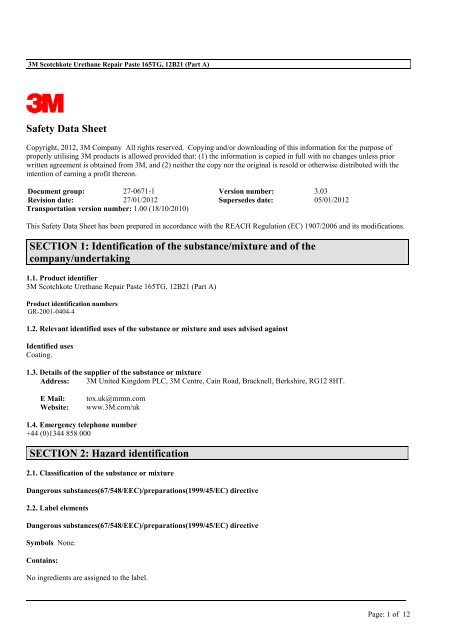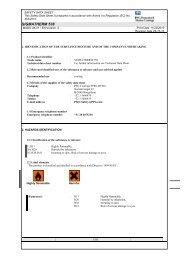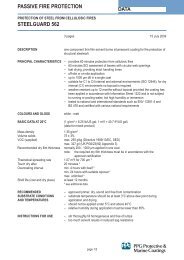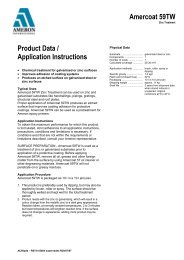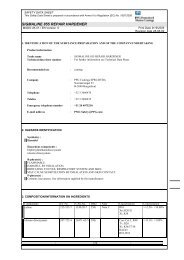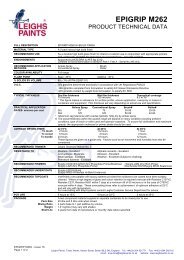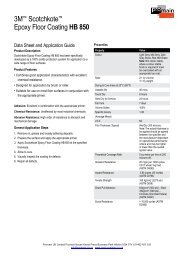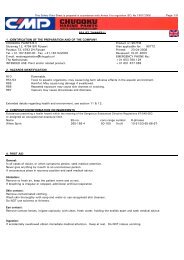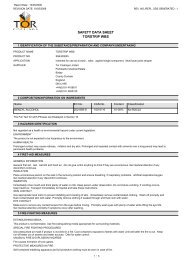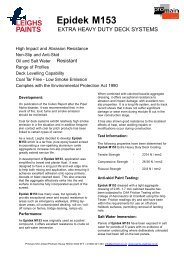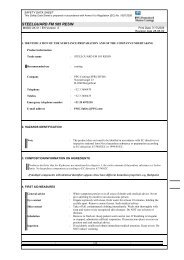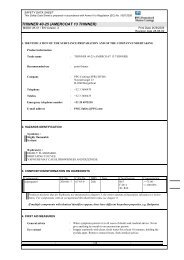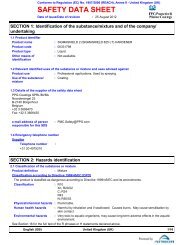3M Scotchkote Urethane Repair Paste 165TG MSDS.pdf - Promain
3M Scotchkote Urethane Repair Paste 165TG MSDS.pdf - Promain
3M Scotchkote Urethane Repair Paste 165TG MSDS.pdf - Promain
You also want an ePaper? Increase the reach of your titles
YUMPU automatically turns print PDFs into web optimized ePapers that Google loves.
<strong>3M</strong> <strong>Scotchkote</strong> <strong>Urethane</strong> <strong>Repair</strong> <strong>Paste</strong> <strong>165TG</strong>, 12B21 (Part A)Safety Data SheetCopyright, 2012, <strong>3M</strong> Company All rights reserved. Copying and/or downloading of this information for the purpose ofproperly utilising <strong>3M</strong> products is allowed provided that: (1) the information is copied in full with no changes unless priorwritten agreement is obtained from <strong>3M</strong>, and (2) neither the copy nor the original is resold or otherwise distributed with theintention of earning a profit thereon.Document group: 27-0671-1 Version number: 3.03Revision date: 27/01/2012 Supersedes date: 05/01/2012Transportation version number: 1.00 (18/10/2010)This Safety Data Sheet has been prepared in accordance with the REACH Regulation (EC) 1907/2006 and its modifications.SECTION 1: Identification of the substance/mixture and of thecompany/undertaking1.1. Product identifier<strong>3M</strong> <strong>Scotchkote</strong> <strong>Urethane</strong> <strong>Repair</strong> <strong>Paste</strong> <strong>165TG</strong>, 12B21 (Part A)Product identification numbersGR-2001-0404-41.2. Relevant identified uses of the substance or mixture and uses advised againstIdentified usesCoating.1.3. Details of the supplier of the substance or mixtureAddress: <strong>3M</strong> United Kingdom PLC, <strong>3M</strong> Centre, Cain Road, Bracknell, Berkshire, RG12 8HT.E Mail:Website:tox.uk@mmm.comwww.<strong>3M</strong>.com/uk1.4. Emergency telephone number+44 (0)1344 858 000SECTION 2: Hazard identification2.1. Classification of the substance or mixtureDangerous substances(67/548/EEC)/preparations(1999/45/EC) directive2.2. Label elementsDangerous substances(67/548/EEC)/preparations(1999/45/EC) directiveSymbols None.Contains:No ingredients are assigned to the label.__________________________________________________________________________________________Page: 1 of 12
<strong>3M</strong> <strong>Scotchkote</strong> <strong>Urethane</strong> <strong>Repair</strong> <strong>Paste</strong> <strong>165TG</strong>, 12B21 (Part A)Risk phrasesR52/53 Harmful to aquatic organisms. May cause long-term adverse effects in the aquatic environment.Safety phrasesS61Avoid release to the environment. Refer to special instructions/safety data sheets.2.3. Other hazardsNone known.SECTION 3: Composition/information on ingredientsIngredient CAS Nbr EU Inventory % by Wt ClassificationCastor oil 8001-79-4 EINECS 232- 40 - 50293-8Non-hazardous ingredients Mixture 30 - 40Chlorite-group minerals 1318-59-8 EINECS 215- 10 - 20285-9Zeolites 1318-02-1 EINECS 215- 5 - 15283-8Diethylmethylbenzenediamine 68479-98-1 EINECS 270-877-41 - 5 Xn:R21-22-48/22; Xi:R36;N:R50/53 - Nota C (EU)Acute Tox. 4, H312; Acute Tox.4, H302; Eye Irrit. 2, H319;STOT RE 2, H373; AquaticAcute 1, H400,M=1; AquaticChronic 1, H410,M=1 - Nota C(CLP)Titanium dioxide 13463-67-7 EINECS 236- 1 - 5675-5chromium (III) oxide 1308-38-9 EINECS 215- < 1160-9Please see section 16 for the full text of any R phrases and H statements referred to in this sectionPlease refer to section 15 for the any applicable Notas that have been applied to the above componentsFor information on ingredient occupational exposure limits or PBT or vPvB status, see sections 8 and 12 of this SDSSECTION 4: First aid measures4.1. Description of first aid measuresEye contactFlush with large amounts of water. Remove contact lenses if easy to do. Continue rinsing. If signs/symptoms persist, getmedical attention.Skin contactWash with soap and water. If signs/symptoms develop, get medical attention.InhalationRemove person to fresh air. If you feel unwell, get medical attention.If swallowedRinse mouth. If you feel unwell, get medical attention.__________________________________________________________________________________________Page: 2 of 12
<strong>3M</strong> <strong>Scotchkote</strong> <strong>Urethane</strong> <strong>Repair</strong> <strong>Paste</strong> <strong>165TG</strong>, 12B21 (Part A)4.2. Most important symptoms and effects, both acute and delayedSee Section 11.1 Information on toxicological effects4.3. Indication of any immediate medical attention and special treatment requiredNot applicableSECTION 5: Fire-fighting measures5.1. Extinguishing mediaIn case of fire: Use a carbon dioxide or dry chemical extinguisher for extinction.5.2. Special hazards arising from the substance or mixtureNone inherent in this product.Hazardous Decomposition or By-ProductsSubstanceCarbon monoxide.Carbon dioxide.ConditionDuring combustion.During combustion.5.3. Advice for fire-fightersNo unusual fire or explosion hazards are anticipated.SECTION 6: Accidental release measures6.1. Personal precautions, protective equipment and emergency proceduresEvacuate area. Ventilate the area with fresh air. For large spill, or spills in confined spaces, provide mechanical ventilationto disperse or exhaust vapours, in accordance with good industrial hygiene practice. Warning: A motor could be an ignitionsource and could cause flammable gases or vapours in the spill area to burn or explode. Refer to other sections of this SDSfor information regarding physical and health hazards, respiratory protection, ventilation, and personal protective equipment.6.2. Environmental precautionsAvoid release to the environment. For larger spills, cover drains and build dykes to prevent entry into sewer systems orbodies of water.6.3. Methods and material for containment and cleaning upContain spill. Working from around the edges of the spill inward, cover with bentonite, vermiculite, or commerciallyavailable inorganic absorbent material. Mix in sufficient absorbent until it appears dry. Remember, adding an absorbentmaterial does not remove a toxic, corrosivity or flammability hazard. Collect as much of the spilled material as possible.Clean up residue with an appropriate solvent selected by a qualified and authorised person. Ventilate the area with fresh air.Read and follow safety precautions on the solvent label and Safety Data Sheet. Place in a closed container approved fortransportation by appropriate authorities. Seal the container. Dispose of collected material as soon as possible.6.4. Reference to other sectionsRefer to Section 8 and Section 13 for more informationSECTION 7: Handling and storage7.1. Precautions for safe handlingAvoid eye contact. For industrial or professional use only. Do not breathe dust/fume/gas/mist/vapours/spray. Do not get ineyes, on skin, or on clothing. Do not eat, drink or smoke when using this product. Wash thoroughly after handling. Avoidrelease to the environment. Avoid contact with oxidising agents (eg. chlorine, chromic acid etc.)7.2. Conditions for safe storage including any incompatibilities__________________________________________________________________________________________Page: 3 of 12
<strong>3M</strong> <strong>Scotchkote</strong> <strong>Urethane</strong> <strong>Repair</strong> <strong>Paste</strong> <strong>165TG</strong>, 12B21 (Part A)Keep container tightly closed to prevent contamination with water or air. If contamination is suspected, do not resealcontainer. Store away from acids. Store away from oxidising agents. Store away from strong bases.7.3. Specific end use(s)See information in Section 7.1 and 7.2 for handling and storage recommendations. See Section 8 for exposure controls andpersonal protection recommendations.SECTION 8: Exposure controls/personal protection8.1 Control parametersOccupational exposure limitsIngredient CAS Nbr Agency Limit type Additional commentsChromium (III) oxide 1308-38-9 Health and TWA(as Cr):0.5 mg/m3Safety Comm.(UK)Aluminum oxides 1318-02-1 Health andSafety Comm.(UK)TWA(as inhalable dust):10mg/m³;TWA(as respirabledust):4 mg/m³Titanium dioxide 13463-67-7 Health andSafety Comm.(UK)Health and Safety Comm. (UK) : UK Health and Safety CommissionTWA: Time-Weighted-AverageSTEL: Short Term Exposure Limitppm: parts per millionmg/m³: milligrams per cubic metreCEIL: Ceiling8.2. Exposure controlsTWA(Inhalable):10mg/m3;TWA(respirable):4mg/m³8.2.1. Engineering controlsCuring enclosures must be exhausted to outdoors or to a suitable emission control device. Use general dilution ventilationand/or local exhaust ventilation to control airborne exposures to below relevant Exposure Limits and/or controldust/fume/gas/mist/vapours/spray. If ventilation is not adequate, use respiratory protection equipment.8.2.2. Personal protective equipment (PPE)Eye/face protectionWear eye/face protection.The following eye protection(s) are recommended: Safety glasses with side shields.Indirect vented goggles.Skin/hand protectionWear protective gloves.Gloves made from the following material(s) are recommended: Butyl rubber.Neoprene.Respiratory protectionIn case of inadequate ventilation wear respiratory protection.Select one of the following approved respirators based on airborne concentration of contaminants and in accordance withregulations:Half facepiece or fullface air-purifying respirator with organic vapour cartridges and P2 particulate prefilters.__________________________________________________________________________________________Page: 4 of 12
<strong>3M</strong> <strong>Scotchkote</strong> <strong>Urethane</strong> <strong>Repair</strong> <strong>Paste</strong> <strong>165TG</strong>, 12B21 (Part A)SECTION 9: Physical and chemical properties9.1. Information on basic physical and chemical propertiesPhysical stateLiquid.Specific Physical Form:Thixotropic liquid.Appearance/OdourFaint oily odour; Grey colour.pHNo data available.Boiling point/boiling range >=300 ºCMelting pointNot applicable.Flammability (solid, gas)Not classifiedExplosive propertiesNot classifiedOxidising propertiesNot classifiedFlash point>=127 ºC [Test Method:Closed Cup]Autoignition temperature >=365 ºCFlammable Limits(LEL)No data available.Flammable Limits(UEL)No data available.Vapour pressure 1,100 Pa [@ 50 ºC ]Relative density1.20 [Ref Std:WATER=1]Water solubilityPartition coefficient: n-octanol/waterEvaporation rateVapour densityViscosityDensityNegligibleNo data available.No data available.No data available.No data available.1.2 g/ml9.2. Other informationVolatile organic compounds (VOC) 3.96 g/l [Details:EU Definition (Part A and Part B mixture)]Percent volatile 0.33 % weightSECTION 10: Stability and reactivity10.1 ReactivityThis material may be reactive with certain agents under certain conditions - see the remaining headings in this section10.2 Chemical stabilityStable.10.3 Possibility of hazardous reactionsHazardous polymerisation will not occur.10.4 Conditions to avoidNone known.10.5 Incompatible materialsAcceleratorsAmines.Reaction with water, alcohols, and amines is not hazardous if container can vent to the atmosphere to prevent pressurebuildup.Strong acids.__________________________________________________________________________________________Page: 5 of 12
<strong>3M</strong> <strong>Scotchkote</strong> <strong>Urethane</strong> <strong>Repair</strong> <strong>Paste</strong> <strong>165TG</strong>, 12B21 (Part A)Strong bases.Strong oxidising agents.10.6 Hazardous decomposition productsSubstanceNone known.ConditionSECTION 11: Toxicological informationThe information below may not be consistent with the material classification in Section 2 if specific ingredientclassifications are mandated by a competent authority. In addition, toxicological data on ingredients may not bereflected in the material classification and/or the signs and symptoms of exposure, because an ingredient may bepresent below the threshold for labelling, an ingredient may not be available for exposure, or the data may not berelevant to the material as a whole.11.1 Information on Toxicological effectsSigns and Symptoms of ExposureBased on test data and/or information on the components, this material may produce the following health effects:Eye contactModerate eye irritation: Signs/symptoms may include redness, swelling, pain, tearing, and blurred or hazy vision.Skin contactContact with the skin during product use is not expected to result in significant irritation.InhalationRespiratory tract irritation: Signs/symptoms may include cough, sneezing, nasal discharge, headache, hoarseness, and noseand throat pain.IngestionGastrointestinal irritation: Signs/symptoms may include abdominal pain, stomach upset, nausea, vomiting and diarrhoea.Target Organ Effects:Prolonged or repeated exposure may cause:Liver effects: Signs/symptoms may include loss of appetite, weight loss, fatigue, weakness, abdominal tendernessand jaundice. Endocrine effects: Signs/symptoms may include disruption of gonadal, thyroid, adrenal, or pancreaticfunction, changes in hormone production, alterations in circulating hormone levels, and/or changes in tissue responseto hormones.Toxicological DataAcute ToxicityName Route Species Value UN GHS ClassificationOverall product Ingestion No test data available;calculated ATE >5,000Not classified(14.28% unknown)mg/kgCastor oil Ingestion LD50 estimated to be > Not classified5,000 mg/kgChlorite-group mineralsNo data availableZeolites Dermal Rabbit LD50 > 2,000 mg/kg Not classifiedZeolitesInhalation- Rat LC50 > 4.57 mg/l Not classifiedDust/Mist (4hours)Zeolites Ingestion Rat LD50 > 5,000 mg/kg Not classified__________________________________________________________________________________________Page: 6 of 12
<strong>3M</strong> <strong>Scotchkote</strong> <strong>Urethane</strong> <strong>Repair</strong> <strong>Paste</strong> <strong>165TG</strong>, 12B21 (Part A)Titanium dioxide Dermal Rabbit LD50 > 10,000 mg/kg Not classifiedTitanium dioxideInhalation- Rat LC50 > 7 mg/l Category5Dust/Mist (4hours)Titanium dioxide Ingestion Rat LD50 > 10,000 mg/kg Not classifiedDiethylmethylbenzenediamine Dermal Rabbit LD50 > 1,000 mg/kg Category4Diethylmethylbenzenediamine Inhalation- Rat LC50 > 0.6125 mg/l Category4Dust/Mist (4hours)Diethylmethylbenzenediamine Ingestion Rat LD50 472 mg/kg Category4chromium (III) oxide Ingestion Rat LD50 > 5,000 mg/kg Not classifiedATE = acute toxicity estimateSkin Corrosion/IrritationName Species Value UN GHS ClassificationOverall productNo test data available; Not classifiedcalculated to cause nosignificant irritationCastor oil Minimal irritation Not classifiedChlorite-group mineralsNo data availableZeolitesNo data availableTitanium dioxide No significant irritation Not classifiedDiethylmethylbenzenediamine No significant irritation Not classifiedchromium (III) oxideNo data availableSerious Eye Damage/IrritationName Species Value UN GHS ClassificationOverall productNo test data available; Category 2Bcalculated to be moderateirritantCastor oil Mild irritant Not classifiedChlorite-group mineralsNo data availableZeolitesNo data availableTitanium dioxide Mild irritant Not classifiedDiethylmethylbenzenediamine Severe irritant Category 2Achromium (III) oxideNo data availableSkin SensitisationName Species Value UN GHS ClassificationOverall product No test data available. Not classified based oncomponent dataCastor oilSome positive data exist, but Not classifiedthe data are not sufficient forclassificationChlorite-group mineralsNo data availableZeolitesNo data availableTitanium dioxide Not sensitizing Not classifiedDiethylmethylbenzenediamineSome positive data exist, but Not classifiedthe data are not sufficient forclassificationchromium (III) oxideNo data availableRespiratory SensitisationName Species Value UN GHS ClassificationOverall product No test data available. Not classified based oncomponent dataCastor oilNo data availableChlorite-group mineralsNo data availableZeolitesNo data available__________________________________________________________________________________________Page: 7 of 12
<strong>3M</strong> <strong>Scotchkote</strong> <strong>Urethane</strong> <strong>Repair</strong> <strong>Paste</strong> <strong>165TG</strong>, 12B21 (Part A)Titanium dioxideDiethylmethylbenzenediaminechromium (III) oxideNo data availableNo data availableNo data availableGerm Cell MutagenicityName Route Value UN GHS ClassificationOverall product No data available Overall Germ Cell Mutagenicityclassification Not classifiedOverall productNo test data available.Castor oil In Vitro Not mutagenic Not classifiedCastor oil In vivo Not mutagenic Not classifiedChlorite-group mineralsNo data availableZeolitesNo data availableTitanium dioxide In Vitro Not mutagenic Not classifiedTitanium dioxide Ingestion Not mutagenic Not classifiedDiethylmethylbenzenediamine In Vitro Some positive data exist, but Not classifiedthe data are not sufficient forclassificationchromium (III) oxideNo data availableCarcinogenicityName Route Species Value UN GHS ClassificationOverall product No test data available. Not classified based oncomponent dataCastor oilNo data availableChlorite-group mineralsNo data availableZeolitesNo data availableTitanium dioxide Ingestion Not carcinogenic Not classifiedTitanium dioxide Inhalation Some positive data Not classifiedexist, but the data arenot sufficient forclassificationDiethylmethylbenzenediamine Ingestion Some positive data Not classifiedexist, but the data arenot sufficient forclassificationchromium (III) oxideNo data availableReproductive ToxicityReproductive and/or Developmental EffectsName Route Value Species Test result ExposureDurationOverall productNo test dataavailable.Castor oil Ingestion Some positivereproductive/developmental data exist,but the data are notsufficient forclassificationChlorite-groupNo data availablemineralsZeolitesNo data availableTitanium dioxideNo data availableDiethylmethylbenzenNo data availableediaminechromium (III) oxideNo data availableNOEL 248mg/kg/dayUN GHSClassificationNot classifiedbased oncomponent data__________________________________________________________________________________________Page: 8 of 12
<strong>3M</strong> <strong>Scotchkote</strong> <strong>Urethane</strong> <strong>Repair</strong> <strong>Paste</strong> <strong>165TG</strong>, 12B21 (Part A)Target Organ(s)TitaniumdioxideDiethylmethylbenzenediaminechromium(III) oxideInhalationrespiratoryirritationavailableSome positivedata exist, butthe data are notsufficient forclassificationNo dataavailableNo dataavailableIrritationPositiveSpecific Target Organ Toxicity - repeated exposureName Route TargetOrgan(s)Value Species Test result ExposureDurationOverallNo test dataproductavailable.Castor oil Ingestion heart Some positive dataexist, but the dataare not sufficientfor classificationCastor oil Ingestion hematopoietic systemSome positive dataexist, but the dataare not sufficientfor classificationCastor oil Ingestion liver Some positive dataexist, but the dataare not sufficientfor classificationCastor oil Ingestion kidneyand/orbladderSpecific Target Organ Toxicity - single exposureName Route TargetOrgan(s)Value Species Test result ExposureDurationCastor oilNo dataavailableChloritegroupNo dataavailablemineralsZeolitesNo dataChloritegroupmineralsZeolitesTitaniumdioxideTitaniumdioxideDiethylmethylbenzenediamineInhalationInhalationIngestionrespiratorysystempulmonaryfibrosisendocrinesystemSome positive dataexist, but the dataare not sufficientfor classificationNo data availableNo data availableSome positive dataexist, but the dataare not sufficientfor classificationAll data arenegativeMay cause damageto organs thoughprolonged orrepeated exposureLOEL 248mg/kg/dayLOEL 300mg/kg/dayNOEL2,000mg/kg/dayNOEL3,000mg/kg/dayNOEL 10mg/m3NOAELN/ANOAEL4.75mg/kg/dayUN GHSClassificationNot classifiedUN GHSClassificationCategory 2 basedon componentdataNot classifiedNot classifiedNot classifiedNot classifiedNot classifiedNot classifiedCategory 2__________________________________________________________________________________________Page: 9 of 12
<strong>3M</strong> <strong>Scotchkote</strong> <strong>Urethane</strong> <strong>Repair</strong> <strong>Paste</strong> <strong>165TG</strong>, 12B21 (Part A)DiethylmethylbenzenediamineDiethylmethylbenzenediaminechromium(III) oxideIngestion liver May cause damageto organs thoughprolonged orrepeated exposureIngestion eyes |kidneyand/orbladderSome positive dataexist, but the dataare not sufficientfor classificationNo data availableLOAEL1.36mg/kg/dayNOEL 4.75mg/kg/dayCategory 2Not classifiedAspiration HazardName Value UN GHS ClassificationOverall product No test data available. Not classified based oncomponent and/or viscositydataCastor oil Not an aspiration hazard Not classifiedChlorite-group minerals Not an aspiration hazard Not classifiedZeolites Not an aspiration hazard Not classifiedTitanium dioxide Not an aspiration hazard Not classifiedDiethylmethylbenzenediamine Not an aspiration hazard Not classifiedchromium (III) oxide Not an aspiration hazard Not classifiedPlease contact the address or phone number listed on the first page of the SDS for additional toxicological informationon this material and/or its components.SECTION 12: Ecological informationThe information below may not be consistent with the material classification in Section 2 if specific ingredient classificationsare mandated by a competent authority. Additional information leading to material classification in Section 2 is availableupon request. In addition, environmental fate and effects data on ingredients may not be reflected in this section because aningredient is present below the threshold for labelling, an ingredient is not expected to be available for exposure, or the datais considered not relevant to the material as a whole.12.1. ToxicityAcute aquatic hazard:GHS Acute 3: Harmful to aquatic life.Chronic aquatic hazard:GHS Chronic 3: Harmful to aquatic life with long lasting effects.No component test data available.Material Organism Type Exposure Test endpoint Test result<strong>3M</strong> <strong>Scotchkote</strong><strong>Urethane</strong> <strong>Repair</strong><strong>Paste</strong> <strong>165TG</strong>,12B21 (Part A)Insufficient toclassify% weight12.2. Persistence and degradabilityNo test data available.12.3 : Bioaccumulative potentialNo test data available.12.4. Mobility in soil__________________________________________________________________________________________Page: 10 of 12
<strong>3M</strong> <strong>Scotchkote</strong> <strong>Urethane</strong> <strong>Repair</strong> <strong>Paste</strong> <strong>165TG</strong>, 12B21 (Part A)Please contact manufacturer for more details12.5. Results of the PBT and vPvB assessmentNo information available at this time, contact manufacturer for more details12.6. Other adverse effectsNo information available.SECTION 13: Disposal considerations13.1 Waste treatment methodsDispose of contents/ container in accordance with the local/regional/national/international regulationsEmpty drums/barrels/containers used for transporting and handling hazardous chemicals (chemicalsubstances/mixtures/preparations classified as hazardous as per applicable regulations) shall be considered,stored,treated &disposed of as hazardous wastes unless otherwise defined by applicable waste regulations. Consult with the respectiveregulating authorities to determine the available treatment and disposal facilities. Incinerate in a permitted waste incinerationfacility. Proper destruction may require the use of additional fuel during incineration processes. As a disposal alternative,Dispose of waste product in a permitted industrial waste facility.The coding of a waste stream is based on the application of the product by the consumer. Since this is out of the control of<strong>3M</strong>, no waste code(s) for products after use will be provided. Please refer to the European Waste Code (EWC - 2000/532/ECand amendments) to assign the correct waste code to your waste stream. Ensure national and/or regional regulations arecomplied with and always use a licensed waste contractor.EU waste code (product as sold)08 01 11* Waste paint and varnish containing organic solvents or other dangerous substancesSECTION 14: Transportation informationGR-2001-0404-4Not hazardous for transportationSECTION 15: Regulatory information15.1. Safety, health and environmental regulations/legislation specific for the substance or mixtureCarcinogenicityIngredient CAS Nbr Classification RegulationTitanium dioxide 13463-67-7 Grp. 2B: Possible human International Agencycarc.for Research on CancerZeolites 1318-02-1 Gr. 3: Not classifiable International Agencyfor Research on CancerGlobal inventory statusContact <strong>3M</strong> for more information. The components of this material are in compliance with the provisions of AustraliaNational Industrial Chemical Notification and Assessment Scheme (NICNAS). Certain restrictions may apply. Contact theselling division for additional information. The components of this material are in compliance with the provisions of JapanChemical Substance Control Law. Certain restrictions may apply. Contact the selling division for additional information. Thecomponents of this product are in compliance with the new substance notification requirements of CEPA. The components ofthis product are in compliance with the chemical notification requirements of TSCA.__________________________________________________________________________________________Page: 11 of 12
<strong>3M</strong> <strong>Scotchkote</strong> <strong>Urethane</strong> <strong>Repair</strong> <strong>Paste</strong> <strong>165TG</strong>, 12B21 (Part A)15.2. Chemical Safety AssessmentNot applicableSECTION 16: Other informationList of relevant H statementsH302H312H319H373H400H410Harmful if swallowed.Harmful in contact with skin.Causes serious eye irritation.May cause damage to organs through prolonged or repeated exposure.Very toxic to aquatic life.Very toxic to aquatic life with long lasting effects.List of relevant R-phrasesR21Harmful in contact with skin.R22Harmful if swallowed.R36Irritating to eyes.R48/22 Harmful: danger of serious damage to health by prolonged exposure if swallowed.R50/53 Very toxic to aquatic organisms. May cause long-term adverse effects in the aquatic environment.Revision information:Not applicable.DISCLAIMER: The information on this Safety Data Sheet is based on our experience and is correct to the best of ourknowledge at the date of publication, but we do not accept any liability for any loss, damage or injury resulting from its use(except as required by law). The information may not be valid for any use not referred to in this Data Sheet or use of theproduct in combination with other materials. For these reasons, it is important that customers carry out their own test tosatisfy themselves as to the suitability of the product for their own intended applications.<strong>3M</strong> United Kingdom <strong>MSDS</strong>s are available at www.<strong>3M</strong>.com/uk__________________________________________________________________________________________Page: 12 of 12


